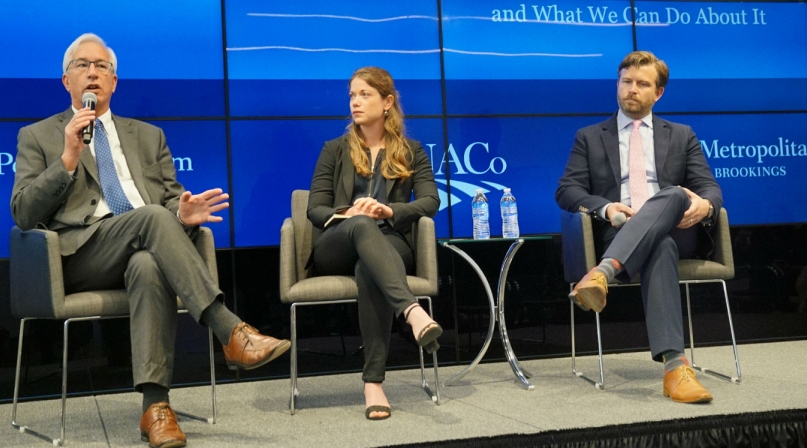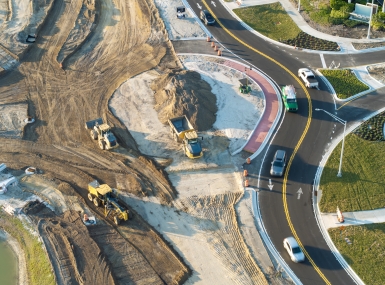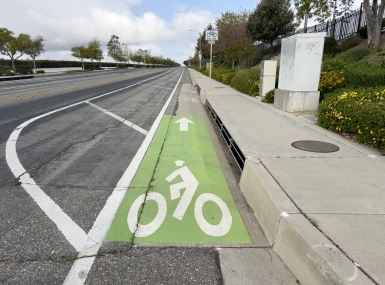Panel says infrastructure assets should be equal for all

Inclusiveness, open discussion during planning key to developing equitable infrastructure
Infrastructure needs to be inclusive, affordable and safe. That was the message from panelists gathered for a discussion on “Building Inclusive Infrastructure,” held at NACo, May 15. The discussion was part of Infrastructure Week 2018, which kicked off May 14.
Most people find out about infrastructure from disasters that make headlines — such as last year’s I-85 bridge collapse in Atlanta or the fatality on a Southwest Airlines flight after a window broke — but it’s everyday infrastructure that also needs to be addressed, said Adie Tomer, fellow, Metropolitan Policy Program at The Brookings Institution, who opened the discussion.
“How do you think about infrastructure every morning when you wake up?” Tomer asked. “You want to make sure there’s clean running water in the bathroom, you want to make sure when you flip the light switch that there’s power on, that the gadgets you have plugged in are fully juiced up because when they’re not it causes real problems all day, right? You also want to make sure you have gas and electricity in the kitchen so you can prepare breakfast. And you definitely want to make sure the broadband into our homes and wi-fi into our routers is running very smoothly. Here’s the real capper … we also want to make sure there’s transportation infrastructure to get us where we need to go.”
These are reasonable expectations, he noted. But there’s a gap in the United States, he said, when you think about entire rural towns where children can’t do homework because they don’t have a broadband connection, communities in Michigan that don’t have clean water or when people have to drive two hours to get to work.
Filling the gaps takes funding and community engagement — two pieces of the puzzle that need to be addressed when considering infrastructure projects, said Ramsey County, Minn. Commissioner Jim McDonough, who was joined on the panel by Ellory Monks, co-founder, the Atlas Marketplace, and Brooks Rainwater, senior executive and director, Center for City Solutions, National League of Cities.
McDonough kicked off the discussion by talking about a project in the 1950s that saw a highway built through an African American neighborhood where there was no community engagement and where people lost their homes to make way for the highway.
“There was no thought about equity or inclusion or how that investment impacted the community,” he said.
Fast forward to the early 2000s, when “we’re starting conversations about building a light rail line,” he said, that was built. It was going through the same community, he said and “those were open wounds that hadn’t even begun to heal over from the highway. The distrust and fear was real.”
“We had a lot of work to do in that community,” he said. That work included adding additional light rail stops that cost $20 million with funding that came through with help from the federal government.
The federal government is often a partner not just in projects such as the light rail system in Minnesota but in areas hit by disasters. Hurricanes Katrina and Sandy shined a light on infrastructure problems, Monks said. “There have been a series of disasters in recent history that really changed how we think about infrastructure and how we think about these issues.”
“Hurricane Sandy really was a turning point,” she said. In the wake of the hurricane there were “tremendous widespread calls to build back better,” which triggered more conversation about what that means.
Rainwater said these kinds of conversations about infrastructure can create “cleavages” in communities. In areas that have seen inequality when building infrastructure, local leaders need to bring communities together, he said.
One of the ways to bring a community together, Monks said, is to identify and empower “project champions, the folks at the local level” who are needed to engage with the public and gain supported with elected leaders. That piece of the puzzle is subtle but important when looking to fund a project, she said.
Elected leaders shouldn’t overlook getting a measure on the ballot to help fund infrastructure projects, Rainwater noted, adding that more than 70 percent of ballot initiatives funding infrastructure projects have passed at the local level since 2000.
As far as private investment in infrastructure, which is being encouraged by the Trump administration, “I think there are opportunities there but the danger we have to pay attention to is it can set the stage for greater inequities in investment because that money is only going to go where there’s a return on investment,” McDonough said. “That’s my biggest concern.”
Private investment comes, he said, when private companies build around public infrastructure.
Private funding can be successful, Monks said, noting that after Hurricane Sandy, a public-private partnership worked on a storm-water management project in Hoboken, N.J. that matched a revenue-generating component with a non-revenue generating component. The project included three layers: an underground storm-water management system, a revenue-generating parking garage and above-ground green recreational space.
Getting authentic citizen engagement in such a project is important and going beyond holding a meeting “where the same 12 people show up,” is crucial, McDonough said.
New ways to get residents involved? Surveys, technology, community partnerships and social media are several ways to do that, Monks said.
McDonough said that an innovative way his county got the community engaged was using interns to knock on doors and hold pop-up meetings handing out popsicles from a van. “We got more than 2,000 comments,” he said. Getting an infrastructure project off the ground means discussing options with citizens, he said. “I need to understand what’s important to the community, but I need to educate them too.”
Attachments
Related News

NACo sends letters to House Transportation and Infrastructure Committee urging support for county priorities in surface transportation reauthorization
On April 30, NACo submitted three letters to the House Transportation and Infrastructure Committee outlining county priorities as Congress begins work on the next surface transportation reauthorization. The current authorization is set to expire on September 30, 2026, and renewing it is a key priority for the Committee in the 119th Congress.

Congress reintroduces bipartisan legislation for bike and pedestrian safety funding expansion
In March, lawmakers in the House and Senate reintroduced the bipartisan Sarah Debbink Langenkamp Active Transportation Safety Act. The legislation honors Sarah Debbink Langenkamp, a former U.S. diplomat and mother of two who was tragically killed while biking home in Bethesda, Md., just weeks after being evacuated from Ukraine in 2022.

FY 25 Update: USDOT announces $982 million through Safe Streets and Roads for All Grant Program
On February 21, the U.S. Department of Transportation announced the availability of $1.2 billion through the Safe Streets and Roads for All competitive grant program in Fiscal Year 2024 for transportation safety planning or construction projects.
